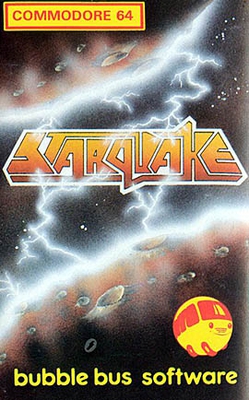
Starquake is an action-adventure platform game written by Stephen Crow for the ZX Spectrum and published by Bubble Bus Software in 1985. It was ported to the Commodore 64, MSX, Amstrad CPC, Atari 8-bit computers, Tatung Einstein, BBC Micro (1987), and IBM compatibles and Atari ST.

Conquests of Camelot: The Search for the Grail is a graphic adventure game released in 1990 by Sierra On-Line. It was the first game in the Conquests series designed by Christy Marx and her husband Peter Ledger. The only other game in the series was 1991's Conquests of the Longbow: The Legend of Robin Hood. Marx did the majority of the design work while Ledger created the game and package art.
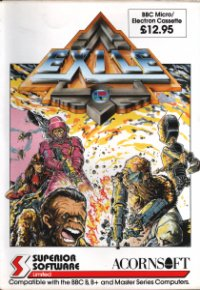
Exile is a single-player action-adventure video game originally published for the BBC Micro and Acorn Electron in 1988 by Superior Software and later ported to the Commodore 64, Amiga, CD32 and Atari ST, all published by Audiogenic. The game was designed and programmed by Peter Irvin and Jeremy Smith. It is often cited as one of the earliest examples of a Metroidvania game and featured "realistic gravity, inertia and object mass years before players understood the concept of a physics engine... an astounding level of AI, stealth-based gameplay, a logical ecosystem governing the world's creatures and a teleportation mechanic that feels startlingly like a predecessor to Portal".

Autoduel is a role-playing video game published by Origin Systems for the Atari 8-bit computers, Commodore 64, Apple II, and IBM PC compatibles in 1985. It was released in 1987 for the Atari ST and in 1988 for the Amiga and Macintosh. The game is based on the Steve Jackson Games series Car Wars.
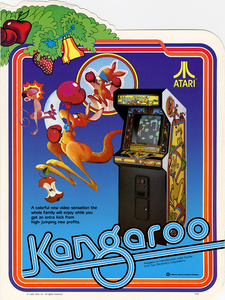
Kangaroo is a four-screen platform game released as an arcade video game 1982 by Sun Electronics and distributed in North America by Atari, Inc. Kangaroo is one of the first arcade games similar in style to Donkey Kong without being a direct clone. The player takes the role of a boxing glove-wearing mother kangaroo who is trying to rescue her joey from fruit-throwing monkeys. Jumping is integral to the game, but there is no jump button. Instead, the player pushes up on the joystick—or up and diagonally—to leap. The arcade version of Kangaroo has visible glitches in the graphics, such as sprites briefly flickering.

Shamus is a shooter with light action-adventure game elements written by Cathryn Mataga and published by Synapse Software. The original Atari 8-bit computer version was released on disk and tape in 1982. According to Synapse co-founder Ihor Wolosenko, Shamus made the company famous by giving it a reputation for quality. "Funeral March of a Marionette", the theme song from Alfred Hitchcock Presents, plays on the title screen.

Fahrenheit is an action-adventure game developed by Quantic Dream and published by Atari for Microsoft Windows, Xbox, and PlayStation 2 in September 2005. The plot follows Lucas Kane, a man who commits murder while supernaturally possessed, and two police detectives investigating the case. Gameplay involves the player in making decisions to alter the narrative.

Eastern Front (1941) is a computer wargame for Atari 8-bit computers created by Chris Crawford and published through the Atari Program Exchange (APX) in 1981. A scenario editor and assembly language source code for the game were also sold by APX as separate products.

Acornsoft's Starship Command is a multidirectional shooter released in 1983 for the BBC Micro and Acorn Electron. It was available on cassette as well as 5.25" disc for the BBC and ROM cartridge for the Acorn Electron Plus 1 expansion module. The game was written by Peter Irvin who, along with Jeremy Smith, went on to create the arcade adventure Exile.

Universal Hero is an action-adventure game released by Mastertronic in 1986 for the ZX Spectrum and in 1987 for the Atari 8-bit computers. The Spectrum version was developed by Stuart Middleton working under the name of Xcel Software. The Atari 8-bit port was commissioned by Mastertronic from a third-party developer.
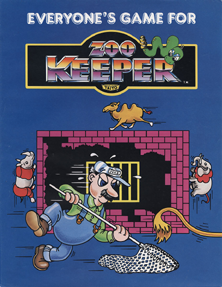
Zoo Keeper is an arcade video game created by Taito America and released in 1983. The player controls Zeke, a zookeeper, attempting to rescue his girlfriend Zelda from a zoo where the animals have escaped from their cages. The majority of the game takes place on a screen where the player builds a wall to keep animals in the zoo—jumping escaped animals to avoid contact. Two different platform game levels are interspersed every few rounds. Zoo Keeper was sold as a conversion kit for Taito's Qix.
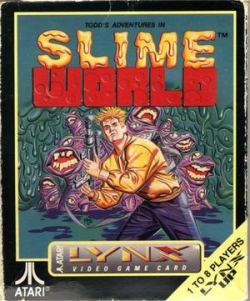
Todd's Adventures in Slime World is a side-scrolling platform video game first released for the Atari Lynx in 1990, with Sega Genesis and PC Engine Super CD-ROM² versions following in 1992.
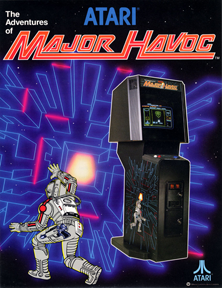
Major Havoc is an arcade action game released by Atari, Inc. in 1984. A vector-based upright arcade cabinet, Major Havoc consists of several smaller game experiences played in succession, including a fixed shooter, platform game, and a lunar lander sequence. It was developed by Owen Rubin with some levels designed and tuned by Mark Cerny, who joined the development team approximately a year into the game's development.
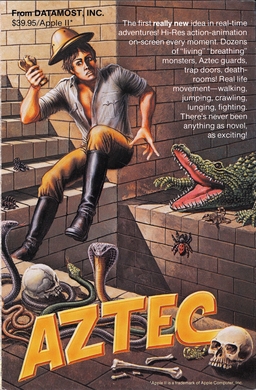
Aztec is an action-adventure game developed by Paul Stephenson for the Apple II and published by Datamost in 1982. It was ported to the Atari 8-bit computers and Commodore 64. In Aztec, the player enters and explores the recently discovered "Tomb of Quetzalcoatl" in Mexico in search of a jade idol.

CJ's Elephant Antics is a platform game developed by Genesis for the Commodore 64 with conversions made for the Amiga, Atari ST, ZX Spectrum and Nintendo Entertainment System. All ports were handled by Genesis with the exception of the ZX Spectrum version which was handled by Big Red Software. The computer versions were published by Codemasters in 1991, with the NES game arriving in 1992 as part of the unlicensed compilation cartridge Quattro Arcade. The player controls a baby elephant by the name of Columbus Jumbo on his way home to Africa.
There have been a variety of Sesame Street video games released for video game platforms. Most of the Sesame Street video games were published and developed by NewKidCo.

Gnome Ranger is a graphic adventure game designed by Peter Austin and released by Level 9 in 1987. A still image is shown for each location, and the player enters text commands to move or interact. Ports to the Apple II and Atari 8-bit computers are text-only. A sequel was published in 1988: Ingrid's Back.
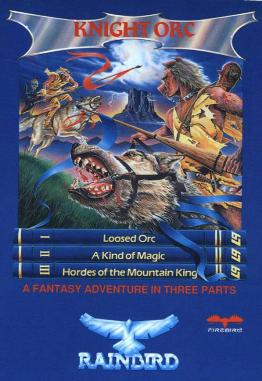
Knight Orc is a text adventure, with limited graphics on some platforms, by Level 9 released in 1987. It comes with a short novella by Peter McBride explaining the background to the story.

Yogi's Great Escape is a 1990 platform game based on the 1987 movie of the same name. It was developed by British studio PAL Developments and published by Hi-Tec Software as a budget game. It was released in Europe for Amiga, Amstrad CPC, Atari ST, Commodore 64, Atari 8bit and ZX Spectrum.

Jet-Boot Jack is a platform game written by Jon Williams for Atari 8-bit computers and published by English Software in 1983. It was ported to the Acorn Electron, Amstrad CPC, BBC Micro, and Commodore 64. A C64-only sequel, Legend of the Knucker-Hole, was released in 1984.




















